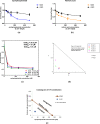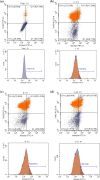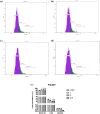SIRT1 as a potential key regulator for mediating apoptosis in oropharyngeal cancer using cyclophosphamide and all-trans retinoic acid
- PMID: 38167952
- PMCID: PMC10761886
- DOI: 10.1038/s41598-023-50478-6
SIRT1 as a potential key regulator for mediating apoptosis in oropharyngeal cancer using cyclophosphamide and all-trans retinoic acid
Abstract
Although cyclophosphamide (CTX) has been used for recurrent or metastatic head and neck cancers, resistance is usually expected. Thus, we conducted this study to examine the effect of adding all-trans retinoic acid (ATRA) to CTX, to increase efficacy of CTX and reduce the risk of resistance developed. In this study, we investigated the combined effect of ATRA and CTX on the expression of apoptotic and angiogenesis markers in oropharyngeal carcinoma cell line (NO3), and the possible involved mechanisms. ATRA and CTX in combination significantly inhibited the proliferation of NO3 cells. Lower dose of CTX in combination with ATRA exhibited significant cytotoxicity than that of CTX when used alone, implying lower expected toxicity. Results showed that ATRA and CTX modulated oxidative stress; increased NOx and MDA, reduced GSH, and mRNA expression of Cox-2, SIRT1 and AMPK. Apoptosis was induced through elevating mRNA expressions of Bax and PAR-4 and suppressing that of Bcl-xl and Bcl-2, parallel with increased caspases 3 and 9 and decreased VEGF, endothelin-1 and CTGF levels. The primal action of the combined regimen on inflammatory signaling highlights its impact on cell death in NO3 cell line which was mediated by oxidative stress associated with apoptosis and suppression of angiogenesis.
© 2024. The Author(s).
Conflict of interest statement
The authors declare no competing interests.
Figures











Similar articles
-
Differential effects of retinoic acid on the growth of isogenic metastatic and non-metastatic breast cancer cell lines and their association with distinct expression of retinoic acid receptor beta isoforms 2 and 4.Int J Oncol. 2003 Mar;22(3):623-9. Int J Oncol. 2003. PMID: 12579317
-
MicroRNA-302b-inhibited E2F3 transcription factor is related to all trans retinoic acid-induced glioma cell apoptosis.J Neurochem. 2014 Dec;131(6):731-42. doi: 10.1111/jnc.12820. Epub 2014 Jul 31. J Neurochem. 2014. PMID: 25040912
-
All Trans Retinoic Acid Attenuates Markers of Neuroinflammation in Rat Brain by Modulation of SIRT1 and NFκB.Neurochem Res. 2018 Sep;43(9):1791-1801. doi: 10.1007/s11064-018-2595-7. Epub 2018 Jul 18. Neurochem Res. 2018. PMID: 30022380
-
[Interferon-β combined with all-trans retinoic acid supresses proliferation and promote apoptosis by inhibiting JAK2/STAT3 pathway in HepG2 human hepatocellular carcinoma cells].Xi Bao Yu Fen Zi Mian Yi Xue Za Zhi. 2016 Jul;32(7):901-5. Xi Bao Yu Fen Zi Mian Yi Xue Za Zhi. 2016. PMID: 27363269 Chinese.
-
Pathways through which a regimen of melatonin and retinoic acid induces apoptosis in MCF-7 human breast cancer cells.Breast Cancer Res Treat. 2000 Jun;61(3):229-39. doi: 10.1023/a:1006442017658. Breast Cancer Res Treat. 2000. PMID: 10965999
Cited by
-
Selisistat, a SIRT1 inhibitor, enhances paclitaxel activity in luminal and triple-negative breast cancer: in silico, in vitro, and in vivo studies.J Enzyme Inhib Med Chem. 2025 Dec;40(1):2458554. doi: 10.1080/14756366.2025.2458554. Epub 2025 Feb 12. J Enzyme Inhib Med Chem. 2025. PMID: 39935420 Free PMC article.
-
Targeting AFP-RARβ complex formation: a potential strategy for treating AFP-positive hepatocellular carcinoma.Mol Divers. 2025 Apr;29(2):1337-1352. doi: 10.1007/s11030-024-10915-8. Epub 2024 Jul 2. Mol Divers. 2025. PMID: 38955977
References
MeSH terms
Substances
LinkOut - more resources
Full Text Sources
Research Materials
Miscellaneous

